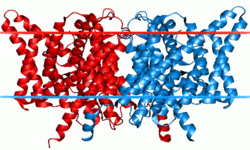- Chloride channel
-

Clc chloride channel Identifiers Symbol Voltage_CLC Pfam PF00654 InterPro IPR014743 SCOP 1kpl TCDB 1.A.11 OPM family 10 OPM protein 1ots Available protein structures: Pfam structures PDB RCSB PDB; PDBe PDBsum structure summary Chloride channels are a superfamily of poorly understood ion channels consisting of approximately 13 members.
Chloride channels display a variety of important physiological and cellular roles that include regulation of pH, volume homeostasis, organic solute transport, cell migration, cell proliferation and differentiation. Based on sequence homology the chloride channels can be subdivided into a number of groups. The importance of one such group, the CLC family of chloride channels, can be seen from the diseases that develop when the channel does not function normally.
This family of ion channels contains 10 or 12 transmembrane helices. Each protein forms a single pore. It has been shown that some members of this family form homodimers. In terms of primary structure, they are unrelated to known cation channels or other types of anion channels. Three CLC subfamilies are found in animals. CLC-1 (P35523) is involved in setting and restoring the resting membrane potential of skeletal muscle, while other channels play important parts in solute concentration mechanisms in the kidney [3]. These proteins contain two CBS domains. Chloride channels are also important for maintaining safe ion concentrations within plant cells.[1]
Contents
Pathology
Bartter's syndrome, which is associated with renal salt wasting and hypokalemic alkalosis, is due to the defective transport of chloride ions and associated ions in the thick ascending loop of Henle. CLCNKB has been implicated.
Another inherited disease that affects the kidney organs is Dent's Disease, characterised by low molecular weight proteinuria and hypercalciuria where mutations in CLCN5 are implicated.
Thomsen disease is associated with dominant mutations and Becker disease with recessive mutations in CLCN1.
Cystic fibrosis is caused by a mutation in the DF508 region of the CFTR gene, which prevents the proper folding of the protein and subsequent degradation, resulting in decreased numbers of chloride channels in the body. This causes the build up of mucus in the body and chronic infections.
Functions
Chloride channels are important for setting cell resting membrane potential and maintaining proper cell volume. These channels conduct Cl- as well as other anions such as HCO3-, I-, SCN-, and NO3-. The structure of these channels are not like other known channels. Chloride channel subunits contain between 1 and 12 transmembrane segments. Some members of this family are activated by voltage, while others are activated by Ca2+, extracellular ligands, and pH among other modulators.[2]
Commercial Applications
Some organic materials disrupt chloride channels in fleas, causing death. Selamectin is the active ingredient in Revolution, a topical insecticide and antihelminthic used on dogs and cats. Selamectin works by replacing glutamate which normally interacts with receptors that open chloride channels at muscle synapses found in parasites. Unlike glutamate, selamectin activates the chloride current without desensitization, thereby producing prolonged hyperpolarization and impaired muscle contraction.
Human genes
- CLCA1, CLCA2, CLCA3, CLCA4
- CLCN1, CLCN2, CLCN3, CLCN4, CLCN5, CLCN6, CLCN7, CLCNKA, CLCNKB
- CLIC1, CLIC2, CLIC3, CLIC4, CLIC5, CLIC6
See also
References
- ^ Li WY, Wong FL, Tsai SN, Phang TH, Shao G, Lam HM (June 2006). "Tonoplast-located GmCLC1 and GmNHX1 from soybean enhance NaCl tolerance in transgenic bright yellow (BY)-2 cells". Plant Cell Environ. 29 (6): 1122–37. doi:10.1111/j.1365-3040.2005.01487.x. PMID 17080938.
- ^ Suzuki M, Morita T, Iwamoto T (January 2006). "Diversity of Cl− Channels". Cell. Mol. Life Sci. 63 (1): 12–24. doi:10.1007/s00018-005-5336-4. PMC 2792346. PMID 16314923. http://www.pubmedcentral.nih.gov/articlerender.fcgi?tool=pmcentrez&artid=2792346.
Further reading
- Schmidt-Rose T, Jentsch TJ (August 1997). "Reconstitution of functional voltage-gated chloride channels from complementary fragments of CLC-1". J. Biol. Chem. 272 (33): 20515–21. doi:10.1074/jbc.272.33.20515. PMID 9252364. http://www.jbc.org/cgi/pmidlookup?view=long&pmid=9252364.
- Zhang J, George AL Jr, Griggs RC, Fouad GT, Roberts J, Kwieciński H, Connolly AM, Ptácek LJ (October 1996). "Mutations in the human skeletal muscle chloride channel gene (CLCN1) associated with dominant and recessive myotonia congenita". Neurology 47 (4): 993–8. PMID 8857733.
- Mindell JA, Maduke M (2001). "ClC chloride channels". Genome Biol. 2 (2): REVIEWS3003. doi:10.1186/gb-2001-2-2-reviews3003. PMC 138906. PMID 11182894. http://genomebiology.com/1465-6906/2/REVIEWS3003.
- Singh H (2010). "Two decades with dimorphic Chloride Intracellular Channels (CLICs)". Febs letters. 584 (10): 2112–21. doi:10.1016/j.febslet.2010.03.013. PMID 20226783.
External links
- MeSH Chloride+channels
- UMich Orientation of Proteins in Membranes families/superfamily-10 - Clc Chloride channels
Ca2+: Calcium channel Ligand-gatedNa+: Sodium channel Constitutively activeProton gatedK+: Potassium channel Kvα1-6 (1.1, 1.2, 1.3, 1.4, 1.5, 1.6, 1.7, 1.8) · (2.1, 2.2) · (3.1, 3.2, 3.3, 3.4) · (4.1, 4.2, 4.3) · (5.1) · (6.1, 6.2, 6.3, 6.4)
Kvα7-12 (7.1, 7.2, 7.3, 7.4, 7.5) · (8.1, 8.2) · (9.1, 9.2, 9.3) · (10.1, 10.2) · (11.1/hERG, 11.2, 11.3) · (12.1, 12.2, 12.3)
Kvβ (1, 2, 3) · KCNIP (1, 2, 3, 4) · minK/ISK · minK/ISK-like · MiRP (1, 2, 3) · Shaker geneOther Cl-: Chloride channelHVCN1Generalsee also disorders
B memb: cead, trns (1A, 1C, 1F, 2A, 3A1, 3A2-3, 3D), othrCategories:- Ion channels
- Transmembrane proteins
- Protein domains
- Protein families
Wikimedia Foundation. 2010.
